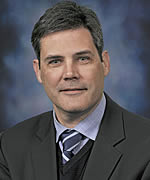Article on suicide personal for ECU therapist
Writing about suicide prevention might not seem unusual for a clinical social worker who counsels patients who may be considering that choice.
But for Sean Pumphrey of East Carolina University, the article in the September-October issue of Social Work Today magazine (http://tinyurl.com/3wfrzgx) was a chance for him to tell his personal story of suicide – the likely cause of his brother’s death 10 years ago.

Sean Pumphrey
At the ECU Physicians Firetower Medical Office where he sees patients, Pumphrey called the article his time to “come out of the closet” and share his brother’s story to help teach others the warning signs of suicide.
His older brother Tom was the “life of the party” who “stuck up for the little guy,” Pumphrey writes. However, he lived with constant self-doubt and negative self-perceptions. Pumphrey once found a suicide note his brother, then in seventh grade, had written. In 1987, after Tom served in the Army, Pumphrey found him overdosed on pills and alcohol.
Tom entered counseling and rehab and attended Alcoholics Anonymous, but it didn’t soothe his despair. In April 2001, he was found dead, a combination of methadone and alcohol in his bloodstream.
Though science can’t say for certain whether Tom died due to an accidental overdose or intentionally took his own life, Pumphrey is sure.
“It does not get better,” Pumphrey said of living without his brother and with the feeling he could have done more to prevent his death. “You may only learn to live with it.”
In his article, Pumphrey writes that women are more likely than men to attempt suicide, but men are more likely to complete suicide. Women prefer drugs; men choose guns.
Suicide risks include depression or other mental illness, substance abuse, a prior suicide attempt, a family history of suicide and firearms in the home. Unemployment, a byproduct of today’s tough economic times, increases the likelihood of suicide, according to the American Academy of Suicidology.
Preventive measures include medicine and psychotherapy. Religious faith and pregnancy are also protective against suicide. Practitioners, friends and family members never know how many suicides they prevent. “But they are left with the pain of those who have been lost to suicide,” Pumphrey writes.
In his 20 years of practice, two of his patients have committed suicide. “That’s tough,” he said. “They hid it.” Many suicide victims, he writes, visit their primary care physician within a month of their deaths.
That’s why recognizing the warning signs and referring patients to therapy is important, and why Dr. Tommy Ellis, a family physician and medical director at the Firetower practice, hired Pumphrey two years ago.
Overall, suicide is the third-leading cause of death in people age 10 to 24, according to the Centers for Disease Control and Prevention. From age 25 to 34, it’s the second-leading cause of death. Suicide is the cause of death for 1.4 percent of whites, 1.7 percent of Asian-Pacific Islanders and 2.6 percent of Native Americans.
In recent decades, the suicide rate among black adolescent males has risen greatly, perhaps due to increased levels of social anxiety, according to one study, but it accounts for fewer than 1 out of 100 deaths among blacks. Cultural and religious beliefs may lower that risk among black adolescents in the South, according to the study.
In therapy, Pumphrey aims to move clients on in their lives as opposed to staying in long-term counseling. “I’m not looking at their problem. I’m looking at their solution” he said. “I want them to become independent rather than dependent.”
Pumphrey was named social worker of the year by the North Carolina Coastal District of the National Association of Social Workers in 2009. He specializes in anxiety, attention deficit-hyperactivity disorder and depression.
For more news about East Carolina University, visit http://www.ecu.edu/cs-admin/news.